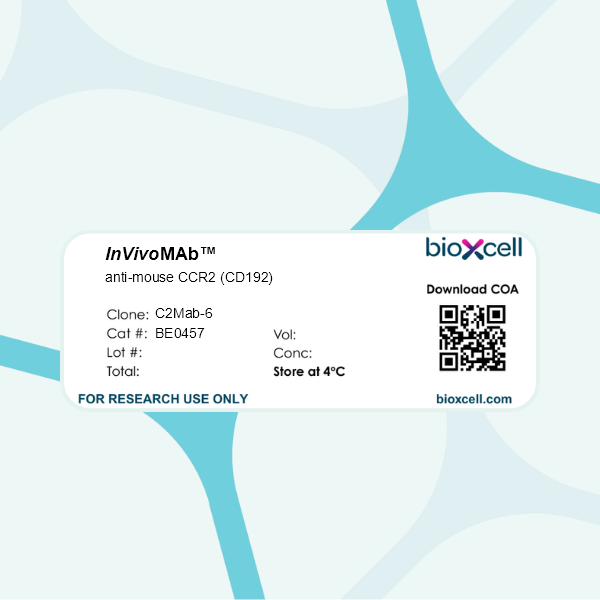InVivoMAb anti-mouse CCR2 (CD192)
Product Description
Specifications
| Isotype | Rat IgG1, κ |
|---|---|
| Recommended Isotype Control(s) | InVivoMAb rat IgG1 isotype control, anti-horseradish peroxidase |
| Recommended Dilution Buffer | InVivoPure pH 7.0 Dilution Buffer |
| Immunogen | Three KLH-conjugated synthetic peptides corresponding to the N-terminal sequence of mouse CCR2 |
| Reported Applications |
Flow cytometry ELISA For details on in vivo applications, please contact technicalservice@bioxcell.com |
| Formulation |
PBS, pH 7.0 Contains no stabilizers or preservatives |
| Endotoxin |
≤1EU/mg (≤0.001EU/μg) Determined by LAL assay |
| Purity |
≥95% Determined by SDS-PAGE |
| Sterility | 0.2 µm filtration |
| Production | Purified from cell culture supernatant in an animal-free facility |
| Purification | Protein G |
| Molecular Weight | 150 kDa |
| Storage | The antibody solution should be stored at the stock concentration at 4°C. Do not freeze. |
| Need a Custom Formulation? | See All Antibody Customization Options |
Application References
ELISA
Tanaka T, Suzuki H, Asano T, Li G, Nanamiya R, Tateyama N, Isoda Y, Okada Y, Kobayashi H, Yoshikawa T, Kaneko MK, Kato Y. (2022). "Epitope Mapping of an Anti-Mouse CCR2 Monoclonal Antibody (C2Mab-6) Using Enzyme-Linked Immunosorbent Assay" Monoclon Antib Immunodiagn Immunother 41(6):339-342.
PubMed
CC chemokine receptor type-2 (CCR2) is a member of the G protein-coupled receptors, and is mainly expressed on cell surface of immune cells. CCR2 binds to its ligand, C-C motif chemokine 2 (also named as monocyte chemoattractant protein-1), which involves in the tumor progression by modulating the tumor microenvironment. Therefore, the monoclonal antibody (mAb) targeting CCR2 could be one of the strategies for cancer treatment. In this study, we investigated the critical epitope of C<sub>2</sub>Mab-6, an anti-mouse CCR2 (mCCR2) mAb developed by N-terminal peptides immunization. We first performed enzyme-linked immunosorbent assay (ELISA) using N-terminal peptides of mCCR2 and demonstrated that C<sub>2</sub>Mab-6 recognizes 1-19 amino acids of mCCR2. We further performed ELISA using 20 alanine-substituted peptides of mCCR2. C<sub>2</sub>Mab-6 lost the reaction to the alanine-substituted peptides of D3A, N4A, M6A, P8A, Q9A, and F10A. These results indicate that the binding epitope of C<sub>2</sub>Mab-6 includes Asp3, Asn4, Met6, Pro8, Gln9, and Phe10 of mCCR2.
Flow Cytometry
ELISA
Tanaka T, Li G, Asano T, Saito M, Kaneko MK, Suzuki H, Kato Y. (2022). "Development of a Novel Anti-Mouse CCR2 Monoclonal Antibody (C2Mab-6) by N-Terminal Peptide Immunization" The CC chemokine receptor type-2 (CCR2) belongs to the G-protein-coupled receptor superfamily, expressed on the cell surface of immune cells and tumors. CCR2 binds to the CC motif chemokine 2/monocyte chemoattractant protein-1, a CC chemokine, which is produced by various cells, including immune-related cells and tumors. Therefore, the development of sensitive monoclonal antibodies (mAbs) for CCR2 has been desired for treatment and diagnosis. This study established a novel, specific, and sensitive anti-mouse CCR2 (mCCR2) mAb; C2Mab-6 (rat IgG1, kappa), using the mCCR2 synthetic peptide immunization method. C2Mab-6 reacted with mCCR2-overexpressed Chinese hamster ovary-K1 cells and L1210 (murine leukemia) cells, which express endogenous mCCR2 in flow cytometry. Furthermore, C2Mab-6 showed a high binding affinity for both cells. Hence, C2Mab-6 can be a useful tool for analyzing mCCR2-related biological responses, using flow cytometry. 41(2):80-86.
PubMed
The CC chemokine receptor type-2 (CCR2) belongs to the G-protein-coupled receptor superfamily, expressed on the cell surface of immune cells and tumors. CCR2 binds to the CC motif chemokine 2/monocyte chemoattractant protein-1, a CC chemokine, which is produced by various cells, including immune-related cells and tumors. Therefore, the development of sensitive monoclonal antibodies (mAbs) for CCR2 has been desired for treatment and diagnosis. This study established a novel, specific, and sensitive anti-mouse CCR2 (mCCR2) mAb; C<sub>2</sub>Mab-6 (rat IgG<sub>1</sub>, kappa), using the mCCR2 synthetic peptide immunization method. C<sub>2</sub>Mab-6 reacted with mCCR2-overexpressed Chinese hamster ovary-K1 cells and L1210 (murine leukemia) cells, which express endogenous mCCR2 in flow cytometry. Furthermore, C<sub>2</sub>Mab-6 showed a high binding affinity for both cells. Hence, C<sub>2</sub>Mab-6 can be a useful tool for analyzing mCCR2-related biological responses, using flow cytometry.

